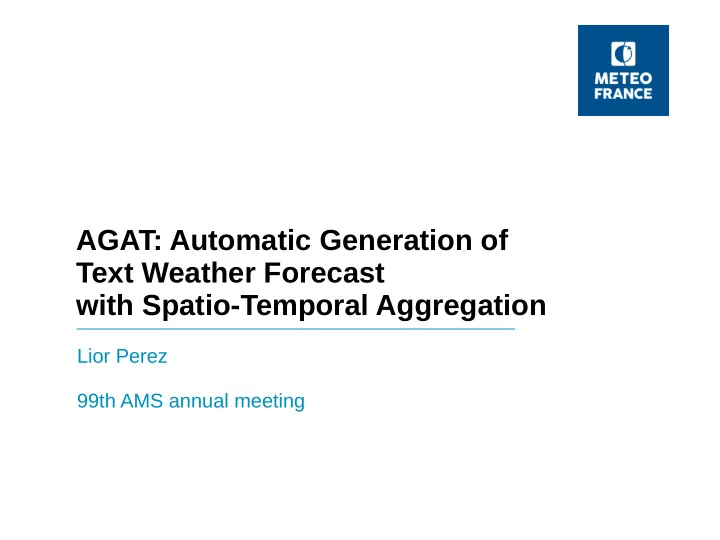

AGAT: Automatic Generation of Text Weather Forecast with Spatio-Temporal Aggregation Lior Perez 99th AMS annual meeting
100 French districts
Situation of October 26 2018 evening 11:00 PM 2:00 AM 5:00 AM 8:00 AM 21:00 UTC 00:00 UTC 03:00 UTC 06:00 UTC Aubrac Causses Rain/snow limit (min) Rain/snow limit (min) Rain/snow limit (min) 2000m 1850m 1500m Max district elevation: 1682m
Text generated by AGAT Original AGAT text (in French) : Le ciel est bien chargé. Les nuages donnent rapidement quelques pluies éparses. Ces ■ précipitations tombent d'abord des Causses à l'Aubrac en soirée, puis partout ailleurs en seconde partie de nuit. Il pleut, puis la limite pluie-neige s'abaisse progressivement à 1550 mètres au lever du jour. Translation (Google Translate with minor adaptations) : The sky is very cloudy. Clouds quickly give scattered rains. ■ This rainfall falls first from Causses to Aubrac in the evening, then everywhere else in the second half of the night. It rains, then the rain-snow limit drops gradually to 1500 meters at sunrise.
How does it work? 2. Get template 1. Sort 3. Post-process from closest areas template « reference situation » ● Reduce complexity ● Find a template written ● Add name of places by a human forecaster ● Add information on for a similar situation precipitation type (rain / snow) ● Add time information
Areas numbers and weather matrix Weather matrix of October 26 2018 evening 21 UTC 00 UTC 03 UTC 06 UTC Area 1 Area 2 1 5 Area 3 2 Area 4 6 4 3 7 Area 5 Area 6 Area 7
1. Sort areas 2. Get template 1. Sort 3. Post-process from closest template areas « reference situation »
1. Sort areas to reduce complexity Weather matrix unsorted Areas with « worst » weather first 21 UTC 00 UTC 03 UTC 06 UTC 21 UTC 00 UTC 03 UTC 06 UTC Area 1 Area 1 Area 5 Area 2 Area 7 Area 3 Area 2 Area 4 Area 3 Area 5 Area 4 Area 6 Area 6 Area 7
2. Get template from closest « reference situation » 2. Get template 1. Sort 3. Post-process from closest template areas « reference situation »
2. Find closest « reference situation » We have defined an euclidian distance between pictograms => we can compute distance between weather matrices Closest reference situation Our situation
2. Find closest « reference situation » Our situation Closest reference situation 21 UTC 00 UTC 03 UTC 06 UTC 21 UTC 00 UTC 03 UTC 06 UTC Area 1 Area 5 Area 7 Area 2 Area 3 Area 4 Area 6
2. Template text for reference situation Original template text (in French) : Le ciel est bien chargé. Les nuages donnent rapidement quelques ■ <précipitations < pluies | chutes de neige > 00 06> éparses. Ces précipitations tombent d’abord <région précipitations 00> en soirée, puis partout en seconde partie de nuit. <LPN 00 06>. Translation (Google Translate with minor adaptations) : The sky is very cloudy. Clouds quickly give scattered ■ <precipitations < rains | snow > 00 06>. This rainfall falls first <area precipitation 00> in the evening, then everywhere else in the second half of the night. <RAIN_SNOW_LIMIT 00 06>
How did we build the « reference situations » database? Data: 2 years of forecast history ■ Unsupervised learning: ■ k-means clustering 1500 clusters homogeneous weather situations For each cluster, ■ a human forecaster has written a template text
3. Post-process template 2. Get template 1. Sort 3. Post-process from closest template areas « reference situation »
3. Post-process tags Rain / snow ■ 21 UTC 00 UTC 03 UTC 06 UTC <precipitations < rains | snow > 00 06> Area 1 From 00 UTC to 06 UTC, only rain, no snow. => « rains » Area 5 <area precipitation 00> ■ Area 7 At 00 UTC, precipitations on areas 1, 5 and 7 In meta-data dictionary: Area 2 1+5+7 = « from Causses to Aubrac » Area 3 <RAIN_SNOW_LIMIT 00 06> ■ Area 4 => « It rains, then the rain-snow limit drops gradually to 1500 meters at sunrise. » Area 6
3. Final text Original AGAT text (in French) : Le ciel est bien chargé. Les nuages donnent rapidement quelques pluies éparses. Ces ■ précipitations tombent d'abord des Causses à l'Aubrac en soirée, puis partout ailleurs en seconde partie de nuit. Il pleut, puis la limite pluie-neige s'abaisse progressivement à 1550 mètres au lever du jour. Translation (Google Translate with minor adaptations) : The sky is very cloudy. Clouds quickly give scattered rains. ■ This rainfall falls first from Causses to Aubrac in the evening, then everywhere else in the second half of the night. It rains, then the rain-snow limit drops gradually to 1500 meters at sunrise.
Conclusion AGAT is in production since 2018 ■ 100 text forecast generated every 15 minutes ■ A lot of time spent on validation ■ Run AGAT on real weather situations ― Check the generated texts ― Correct the reference situations database ― Easy to maintain: adding new reference situations is simple ■ Lior.perez@meteo.fr
Recommend
More recommend